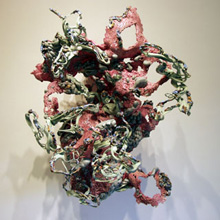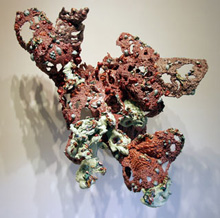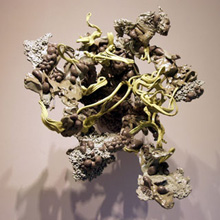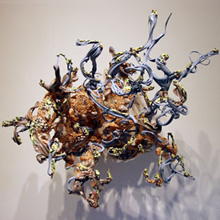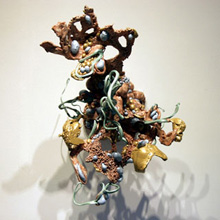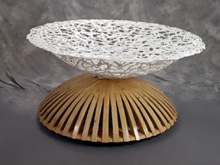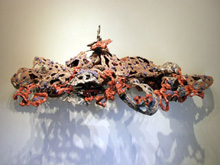Richard Van Buren
Spirit Mold
November 15 - December 21, 2002
Fog Dance titles one of Richard Van Buren’s elusive (and illusive) swirls of toxic beauty hovering on the wall. You are not so much confronted as seductively challenged by an exotic, liquid structure, unnaturally natural or naturally unnatural, depending on those personal experiences from which you may draw. From the distance, it looks as fleeting as a whirlwind driven fog might be, but a fog embraced by a muted rainbow. If you join the piece close up, the fog condenses and congeals into an agitated amalgam of serpentine tendrils twirling around and/or encrusted with countless tiny mercurial beads. This seeming increase in materiality, however, delivers no more certainty than a fog. As in most art, certainty has not been aimed for here but rather a materialization of ambiguity — a pedestal for a dialogue between the viewer’s imagination and that of the maker, a kind of fog dance, a very clear fog.
For some ten years Van Buren has been forming these baroque outbursts — reflecting biological (marine), botanical, and meteorological forces, or sometimes, hybrids of all three. He began with a linear wave comprised of countless pins, the head of each pin deformed/ reformed with a minuscule chunk of paint; and subsequently, he turned to plastic, intertwining evermore complex waves of frozen liquidity bristling with beads/barnacles/crystals. They do not represent anything empirically observed, but rather they materialize Van Buren’s looking at and imagining the forces of nature structurally — seeing/imagining the dynamics of a mutating, organic geometry. The geometry of nature, the geometry of the imagination, these are geometries that subtly blend the seemingly haphazard with the more explicitly ordered. Think of how the memory of something objectively observed is often modified by the mental climate affecting you at the specific moment of recall, or how the seemingly irregular vagaries of meteorological phenomena might modify the symmetrical inclinations of a tree’s bark patterning.
In the 1960s, at the outset of his artistic maturity, Van Buren’s sculptures were measured by a more readily visible rectilinear geometry. However, his structures were not as prone to the mechanical regularity and home appliance-like neutrality of form and coldness of surface so endemic to the work of many of his Minimalist peers. His solid wood geometries were cast in thick layers of fiberglass that softened their sharp edges with a smoky, often roseate glow and made the still visible wood grain more illusive. His structuring, whether asymmetrically cantilevered or diagonally torqued, further softened the acute angularity of the constituent forms. In short, his structuring made those forms and their spatial dynamics more organic. Increasingly, in subsequent years, Van Buren’s sculpture literally and figuratively melted in the heat of organic forming — an organic forming extruded from the utter artificiality of plastic.
The seamless fusion of contradictions — such as the natural and the unnatural, the liquid and the solid, chance and deliberation — is embedded in the procedures of creating. For thirty years Van Buren has spent time in Perry on Maine’s coast, and Perry has now become his primary place of work. Unavoidably he is always looking at water, and in his youth he was a scuba diver. The rhythmic churning of the ocean, the serial structuring of many corals (invertebrate animals that often look like rock formations and embody one of nature’s more extravagant visual contradictions) have certainly impacted Van Buren’s sculpture. But so too has growing up in America’s capital of artificiality, Hollywood, where his father was a movie producer. The confectionery rainbow that tints so much of life in Los Angeles would seem very off in the urban grayness of our East Coast cities. As much as stereotypes might be mistrusted, it is hard to imagine Ad Reinhardt’s black on black paintings or Brice Marden’s restraint-stained arabesques having emanated from L.A. The memory of his mother’s orange lamp goes off like a siren in Van Buren’s head. He wants to employ an aberrant palette but wants it to work. The artificiality of Hollywood and the churning rhythms of the ocean, as well as the creatures of its depths, can simultaneously impact what we are seeing.
Van Buren’s sculpture resonates with a polymorphous referentiality. The pulled and twisted stretches of lurid pink seen in Bazooka may as readily call to elongated strands of chewed bubble gum that the title seems to suggest as to some intestinal delirium or to the skeletal membrane of some coral structure. While the ovoid shape of Toluca Lake is likely referring to the shape of the lake’s circumference, the fantastical arabesques of its ribboning filigree call up visions of a writhing swarm of snakes and crustaceans. As hybridized as these sculpture’s references appear, so too is the method of their materialization hybridized. They are made of thermoplastic — a plastic that becomes malleable when subjected to heat and solidifies with cold — in flat sheets with a grid of holes or in the form of small pellets. Using a hot gun, Van Buren distends the gridded plastic sheet, pushing and pulling, twisting and turning with his hands, then pushes heated pellets through the now enlarged and distorted holes. The individual pellets are the size of rice kernels and can be kneaded together into clay-like strips or formed into the variously sized beads that encrust the surface. Immersion in cold water hardens the structure; hot water brings it back to the consistency of clay. If dropped into water, gravity joins in the manipulation of the form. The solid becomes a liquid, which in turn becomes solidified liquidity. The rational measure of the grid becomes the spontaneous, imagined measure of the hand’s forming. Material liquidity and metaphorical liquidity become one. These seemingly spontaneous eruptions of liquidity acquire much of their animation through the meticulous painting of the finished structure, detail by detail, millimeter by millimeter in a palette of another plastic (acrylic) that can be as artificial as it can be natural.
Recently, another kind of imagined geometry has figured in Van Buren’s work. In the course of his Maine life, he has had contact with members of the Passamaquoddy Indian tribe. The Passamaquoddy, especially those of Van Buren’s generation, have worked hard to maintain their native American traditions, their unique language, and the art of basket weaving, for which they are known. Now working with two members of the tribe, Van Buren has designed the form for a basket that David Moses Bridges has woven from strips of birch bark. Van Buren, has pushed heated thermoplastic through the open grid of the woven basket, instead of through a thermoplastic grid. Already he has cast into Ryan Newell’s basket molds echoing their forms with layered membranes of painted thermoplastic. Called Spirit Mold Project, these freestanding pieces make exotically fabulous the double meaning of mold as a matrix for shaping and as a fungus. Thus addinganother layer to the shifting medley of natural and unnatural and adding yet another measure to his work. Two cultures each riffing on the other.
While Van Buren’s open and extravagant embraces of beauty can not readily be connected to a specific group or style, the lush variegations of his plastic tides run parallel to the efforts of younger artists more willingly attracted to the slippery rewards of beauty than their elders — artists like Udomsak Krisanamis who transmutes detritus into bewitched grids or Chris Ofili who creates bejeweled and bedazzled cosmicomics. To this renewed pursuit of beauty, Van Buren has added his handmade thermoplastic fantastic.
Klaus Kertess
New York, NY
November 2002
Back to top

|
|




